Ting Song
Anatomy-Guided Multitask Learning for MRI-Based Classification of Placenta Accreta Spectrum and its Subtypes
May 23, 2025Abstract:Placenta Accreta Spectrum Disorders (PAS) pose significant risks during pregnancy, frequently leading to postpartum hemorrhage during cesarean deliveries and other severe clinical complications, with bleeding severity correlating to the degree of placental invasion. Consequently, accurate prenatal diagnosis of PAS and its subtypes-placenta accreta (PA), placenta increta (PI), and placenta percreta (PP)-is crucial. However, existing guidelines and methodologies predominantly focus on the presence of PAS, with limited research addressing subtype recognition. Additionally, previous multi-class diagnostic efforts have primarily relied on inefficient two-stage cascaded binary classification tasks. In this study, we propose a novel convolutional neural network (CNN) architecture designed for efficient one-stage multiclass diagnosis of PAS and its subtypes, based on 4,140 magnetic resonance imaging (MRI) slices. Our model features two branches: the main classification branch utilizes a residual block architecture comprising multiple residual blocks, while the second branch integrates anatomical features of the uteroplacental area and the adjacent uterine serous layer to enhance the model's attention during classification. Furthermore, we implement a multitask learning strategy to leverage both branches effectively. Experiments conducted on a real clinical dataset demonstrate that our model achieves state-of-the-art performance.
BitNet b1.58 2B4T Technical Report
Apr 16, 2025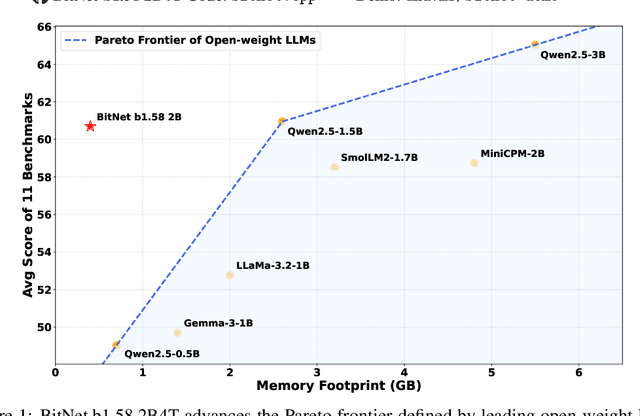
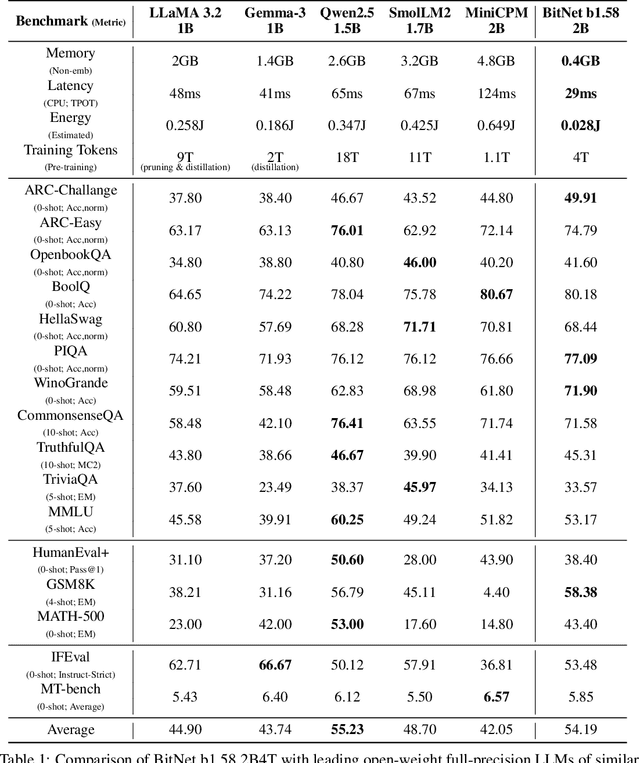
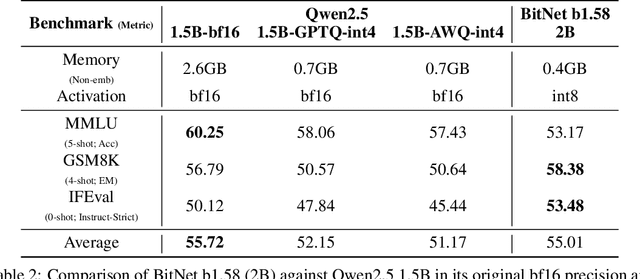
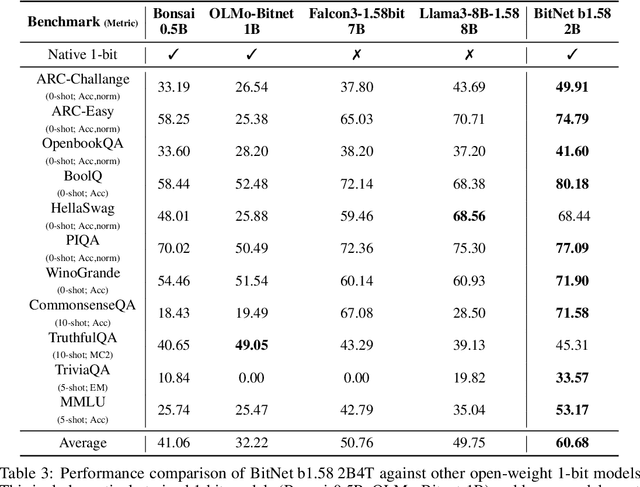
Abstract:We introduce BitNet b1.58 2B4T, the first open-source, native 1-bit Large Language Model (LLM) at the 2-billion parameter scale. Trained on a corpus of 4 trillion tokens, the model has been rigorously evaluated across benchmarks covering language understanding, mathematical reasoning, coding proficiency, and conversational ability. Our results demonstrate that BitNet b1.58 2B4T achieves performance on par with leading open-weight, full-precision LLMs of similar size, while offering significant advantages in computational efficiency, including substantially reduced memory footprint, energy consumption, and decoding latency. To facilitate further research and adoption, the model weights are released via Hugging Face along with open-source inference implementations for both GPU and CPU architectures.
Bitnet.cpp: Efficient Edge Inference for Ternary LLMs
Feb 17, 2025Abstract:The advent of 1-bit large language models (LLMs), led by BitNet b1.58, has spurred interest in ternary LLMs. Despite this, research and practical applications focusing on efficient edge inference for ternary LLMs remain scarce. To bridge this gap, we introduce Bitnet.cpp, an inference system optimized for BitNet b1.58 and ternary LLMs. Given that mixed-precision matrix multiplication (mpGEMM) constitutes the bulk of inference time in ternary LLMs, Bitnet.cpp incorporates a novel mpGEMM library to facilitate sub-2-bits-per-weight, efficient and lossless inference. The library features two core solutions: Ternary Lookup Table (TL), which addresses spatial inefficiencies of previous bit-wise methods, and Int2 with a Scale (I2_S), which ensures lossless edge inference, both enabling high-speed inference. Our experiments show that Bitnet.cpp achieves up to a 6.25x increase in speed over full-precision baselines and up to 2.32x over low-bit baselines, setting new benchmarks in the field. Additionally, we expand TL to element-wise lookup table (ELUT) for low-bit LLMs in the appendix, presenting both theoretical and empirical evidence of its considerable potential. Bitnet.cpp is publicly available at https://github.com/microsoft/BitNet/tree/paper , offering a sophisticated solution for the efficient and practical deployment of edge LLMs.
1-bit AI Infra: Part 1.1, Fast and Lossless BitNet b1.58 Inference on CPUs
Oct 21, 2024Abstract:Recent advances in 1-bit Large Language Models (LLMs), such as BitNet and BitNet b1.58, present a promising approach to enhancing the efficiency of LLMs in terms of speed and energy consumption. These developments also enable local LLM deployment across a broad range of devices. In this work, we introduce bitnet.cpp, a tailored software stack designed to unlock the full potential of 1-bit LLMs. Specifically, we develop a set of kernels to support fast and lossless inference of ternary BitNet b1.58 LLMs on CPUs. Extensive experiments demonstrate that bitnet.cpp achieves significant speedups, ranging from 2.37x to 6.17x on x86 CPUs and from 1.37x to 5.07x on ARM CPUs, across various model sizes. The code is available at https://github.com/microsoft/BitNet.
LLM as a Mastermind: A Survey of Strategic Reasoning with Large Language Models
Apr 01, 2024Abstract:This paper presents a comprehensive survey of the current status and opportunities for Large Language Models (LLMs) in strategic reasoning, a sophisticated form of reasoning that necessitates understanding and predicting adversary actions in multi-agent settings while adjusting strategies accordingly. Strategic reasoning is distinguished by its focus on the dynamic and uncertain nature of interactions among multi-agents, where comprehending the environment and anticipating the behavior of others is crucial. We explore the scopes, applications, methodologies, and evaluation metrics related to strategic reasoning with LLMs, highlighting the burgeoning development in this area and the interdisciplinary approaches enhancing their decision-making performance. It aims to systematize and clarify the scattered literature on this subject, providing a systematic review that underscores the importance of strategic reasoning as a critical cognitive capability and offers insights into future research directions and potential improvements.
Not All Languages Are Created Equal in LLMs: Improving Multilingual Capability by Cross-Lingual-Thought Prompting
May 11, 2023



Abstract:Large language models (LLMs) demonstrate impressive multilingual capability, but their performance varies substantially across different languages. In this work, we introduce a simple yet effective method, called cross-lingual-thought prompting (XLT), to systematically improve the multilingual capability of LLMs. Specifically, XLT is a generic template prompt that stimulates cross-lingual and logical reasoning skills to enhance task performance across languages. We conduct comprehensive evaluations on 7 typical benchmarks related to reasoning, understanding, and generation tasks, covering both high-resource and low-resource languages. Experimental results show that XLT not only remarkably enhances the performance of various multilingual tasks but also significantly reduces the gap between the average performance and the best performance of each task in different languages. Notably, XLT brings over 10 points of average improvement in arithmetic reasoning and open-domain question-answering tasks.
Low-code LLM: Visual Programming over LLMs
Apr 20, 2023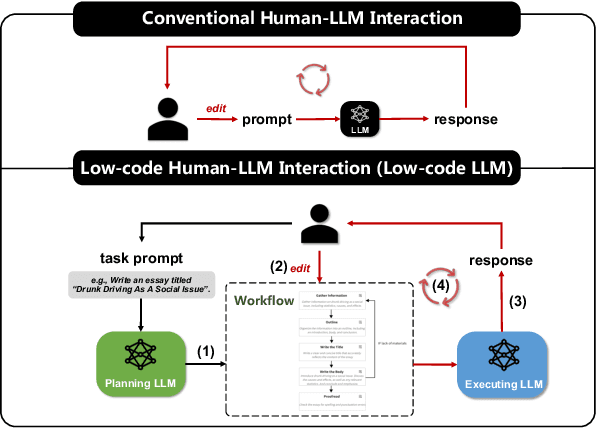

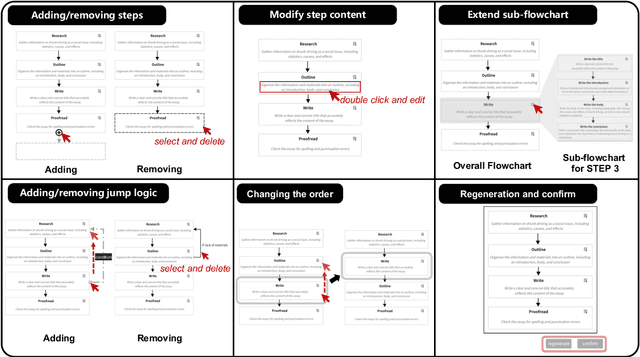
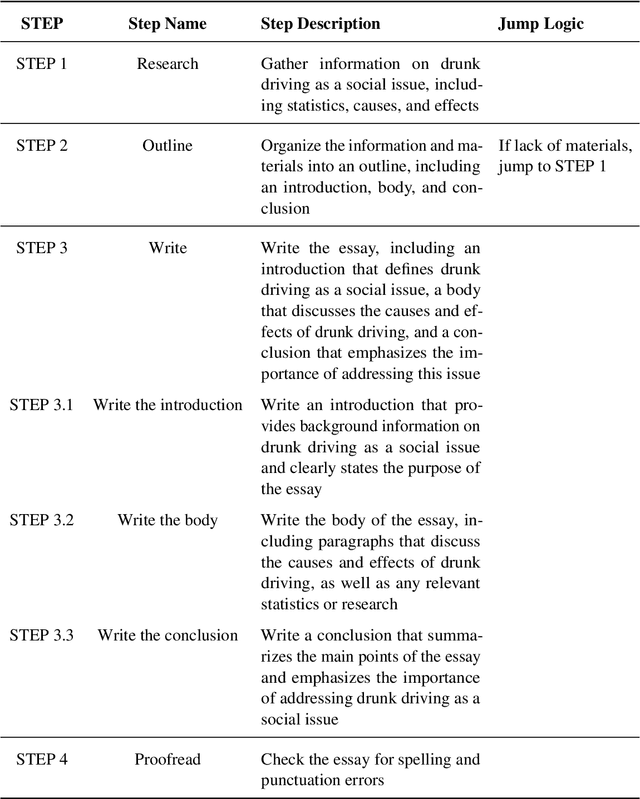
Abstract:Effectively utilizing LLMs for complex tasks is challenging, often involving a time-consuming and uncontrollable prompt engineering process. This paper introduces a novel human-LLM interaction framework, Low-code LLM. It incorporates six types of simple low-code visual programming interactions, all supported by clicking, dragging, or text editing, to achieve more controllable and stable responses. Through visual interaction with a graphical user interface, users can incorporate their ideas into the workflow without writing trivial prompts. The proposed Low-code LLM framework consists of a Planning LLM that designs a structured planning workflow for complex tasks, which can be correspondingly edited and confirmed by users through low-code visual programming operations, and an Executing LLM that generates responses following the user-confirmed workflow. We highlight three advantages of the low-code LLM: controllable generation results, user-friendly human-LLM interaction, and broadly applicable scenarios. We demonstrate its benefits using four typical applications. By introducing this approach, we aim to bridge the gap between humans and LLMs, enabling more effective and efficient utilization of LLMs for complex tasks. Our system will be soon publicly available at LowCodeLLM.
TaskMatrix.AI: Completing Tasks by Connecting Foundation Models with Millions of APIs
Mar 29, 2023



Abstract:Artificial Intelligence (AI) has made incredible progress recently. On the one hand, advanced foundation models like ChatGPT can offer powerful conversation, in-context learning and code generation abilities on a broad range of open-domain tasks. They can also generate high-level solution outlines for domain-specific tasks based on the common sense knowledge they have acquired. However, they still face difficulties with some specialized tasks because they lack enough domain-specific data during pre-training or they often have errors in their neural network computations on those tasks that need accurate executions. On the other hand, there are also many existing models and systems (symbolic-based or neural-based) that can do some domain-specific tasks very well. However, due to the different implementation or working mechanisms, they are not easily accessible or compatible with foundation models. Therefore, there is a clear and pressing need for a mechanism that can leverage foundation models to propose task solution outlines and then automatically match some of the sub-tasks in the outlines to the off-the-shelf models and systems with special functionalities to complete them. Inspired by this, we introduce TaskMatrix.AI as a new AI ecosystem that connects foundation models with millions of APIs for task completion. Unlike most previous work that aimed to improve a single AI model, TaskMatrix.AI focuses more on using existing foundation models (as a brain-like central system) and APIs of other AI models and systems (as sub-task solvers) to achieve diversified tasks in both digital and physical domains. As a position paper, we will present our vision of how to build such an ecosystem, explain each key component, and use study cases to illustrate both the feasibility of this vision and the main challenges we need to address next.
Emerging Threats in Deep Learning-Based Autonomous Driving: A Comprehensive Survey
Oct 19, 2022



Abstract:Since the 2004 DARPA Grand Challenge, the autonomous driving technology has witnessed nearly two decades of rapid development. Particularly, in recent years, with the application of new sensors and deep learning technologies extending to the autonomous field, the development of autonomous driving technology has continued to make breakthroughs. Thus, many carmakers and high-tech giants dedicated to research and system development of autonomous driving. However, as the foundation of autonomous driving, the deep learning technology faces many new security risks. The academic community has proposed deep learning countermeasures against the adversarial examples and AI backdoor, and has introduced them into the autonomous driving field for verification. Deep learning security matters to autonomous driving system security, and then matters to personal safety, which is an issue that deserves attention and research.This paper provides an summary of the concepts, developments and recent research in deep learning security technologies in autonomous driving. Firstly, we briefly introduce the deep learning framework and pipeline in the autonomous driving system, which mainly include the deep learning technologies and algorithms commonly used in this field. Moreover, we focus on the potential security threats of the deep learning based autonomous driving system in each functional layer in turn. We reviews the development of deep learning attack technologies to autonomous driving, investigates the State-of-the-Art algorithms, and reveals the potential risks. At last, we provides an outlook on deep learning security in the autonomous driving field and proposes recommendations for building a safe and trustworthy autonomous driving system.
 Add to Chrome
Add to Chrome Add to Firefox
Add to Firefox Add to Edge
Add to Edge